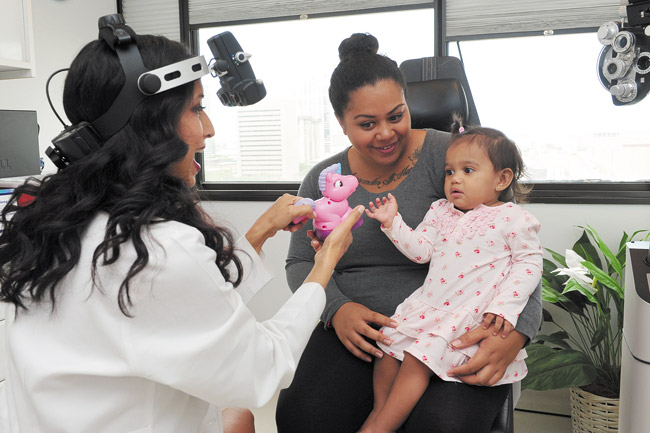Keeping Pinkeye At Bay
Dr. Rupa Wong
Pediatric ophthalmologist with Honolulu Eye Clinic
Where did you receive your schooling/training?
I earned my medical degree from Cornell University Medical College, and then went on to a residency in ophthalmology at New York University-Manhattan Eye, Ear and Throat Hospital, serving as chief resident in my final year. I completed a specialized fellowship in pediatric ophthalmology and adult strabismus at Harvard’s pediatric hospital, Boston Children’s Hospital.
mw-dih-dr-rupa-wong-nw2
How long have you been in practice?
Seven years.
What got you interested in the field of pediatric ophthalmology?
There is nothing as rewarding as being able to restore sight to a child, whether through surgery or a simple pair of glasses.
How big of a problem is pinkeye (conjunctivitis)?
Pinkeye affects Hawaii with the same incidence as any other state on the Mainland. About 6 million people in the U.S. are afflicted with pinkeye every year, primarily children. Many adults get conjunctivitis as well, though adults tend to get viral conjunctivitis more frequently, and children tend to develop bacterial conjunctivitis.
There were about 2,300 cases of pinkeye in students on American Samoa a few weeks ago. That certainly impacts Hawaii because of the contagiousness of viral conjunctivitis and the frequent travelers we get here in Hawaii from American Samoa. Airplanes are hotbeds for bacteria and viruses, since the armrests and tray tables are rarely wiped down. These areas are the perfect reservoir for conjunctivitis to spread. This serves as another reminder to constantly and vigilantly practice good hygiene.
Can you talk more about what causes pinkeye and how easily it spreads?
What people call “pinkeye” can be many different diagnoses. The term pinkeye arose because the white of the eye, the conjunctiva, becomes irritated or pink because of infection or inflammation. But pinkeye can be caused by viruses, bacteria or allergies, and each has different symptoms and different treatments. The two kinds that are contagious are the infectious ones: viral conjunctivitis and bacterial conjunctivitis.
Viral conjunctivitis is extremely contagious and is most commonly caused by adenovirus. This virus can live on the surface of inanimate objects for up to 30 minutes, making transmission very easy. If a person with viral conjunctivitis touches a doorknob or paper after wiping their eyes and someone else touches those same surfaces, they are now at risk. Unfortunately, there is no real treatment for viral conjunctivitis, just as there is no cure for the common cold. However, there is a new test that can be performed by ophthalmologists called AdenoPlus, which can help accurately diagnose this type of infection. If you or your child test positive for adenovirus, you should stay home for at least five to seven days, since the infection is highly contagious at this point.
Bacterial conjunctivitis is contagious, but not to the degree of viral conjunctivitis, and can be treated with antibiotics. It’s usually safe to return to work or school within two days, if on antibiotic drops.
Is there a seasonal aspect to the spread of pinkeye?
We tend to see an increase in the spring and summer months. However, it is seen in the clinic year-round.
How do symptoms differ in viral and bacterial conjunctivitis?
Patients with viral conjunctivitis have watery, red, swollen eyes with mucus. Typically, it starts in one eye and spreads quickly to the other. Symptoms last for one to two weeks and can be preceded by an upper respiratory infection. Kids usually have swelling of the lymph nodes in front of their ears or on their neck.
Bacterial conjunctivitis causes thick discharge and intense redness and tearing of the eyes. Symptoms quickly improve once antibiotic drops are started. Allergic conjunctivitis also presents with redness, tearing and discharge, but the amount of discharge is usually more stringy and most kids complain of extreme itching.
What precautions can people take?
Wash your hands constantly and use a fresh tissue for cleaning the eyes, throwing it away immediately. Use cold compresses and antihistamines, if necessary. Throw away old makeup and don’t wear contact lenses. Instruct your children on the importance of not sharing sunglasses, eye makeup, drops or contact lenses … Yes, I’ve seen teenagers sharing colored contact lenses!
If your child is diagnosed with bacterial conjunctivitis, start using the drops as instructed immediately. You should keep your child home from school until the redness is gone so that they do not spread the infection. Often, the risk of contagion from a bacterial infection resolves within a day or so after a child starts an antibiotic. Viral infections usually resolve more slowly, requiring three days to two weeks at home. Since there is no real treatment for viral conjunctivitis, supportive measures are the best: Wash all towels, linens and pillowcases in hot water daily to prevent the spread of infection. Try to prevent your child from constantly touching their eyes, and wipe down everything, within reason, that you can in the bathroom and bedroom areas to prevent other members of the family from developing the infection.
At what point should a person visit the doctor?
Viral and bacterial conjunctivitis usually resolve within one to two weeks, even without treatment. If your child’s symptoms persist past that point, you should bring them to a pediatric ophthalmologist to assess for other causes of red eyes, like trauma, inflammation and allergy. The AdenoPlus test is more accurate earlier in the illness, so if you want a definitive diagnosis, see your eye doctor sooner.
Unfortunately, studies show that the vast majority of health care professionals – 95 percent – give patients antibiotic drops for pinkeye, whether it’s viral or bacterial. However, antibiotics are not effective in treating viral conjunctivitis and actually can delay proper treatment, lead to antibiotic resistance or potential allergies or even toxicities from the medications. Sometimes, simple, supportive measures such as tear drops and cold compresses are the best treatment.






